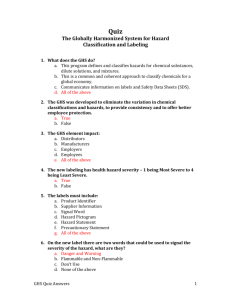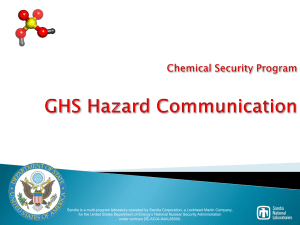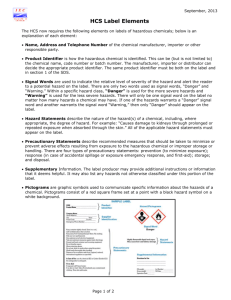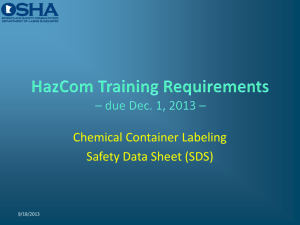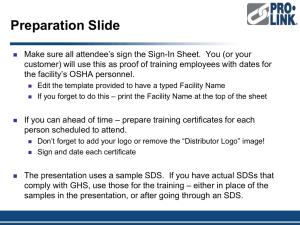His job, the Metalworkers Alliance of the Philippines union leader
advertisement
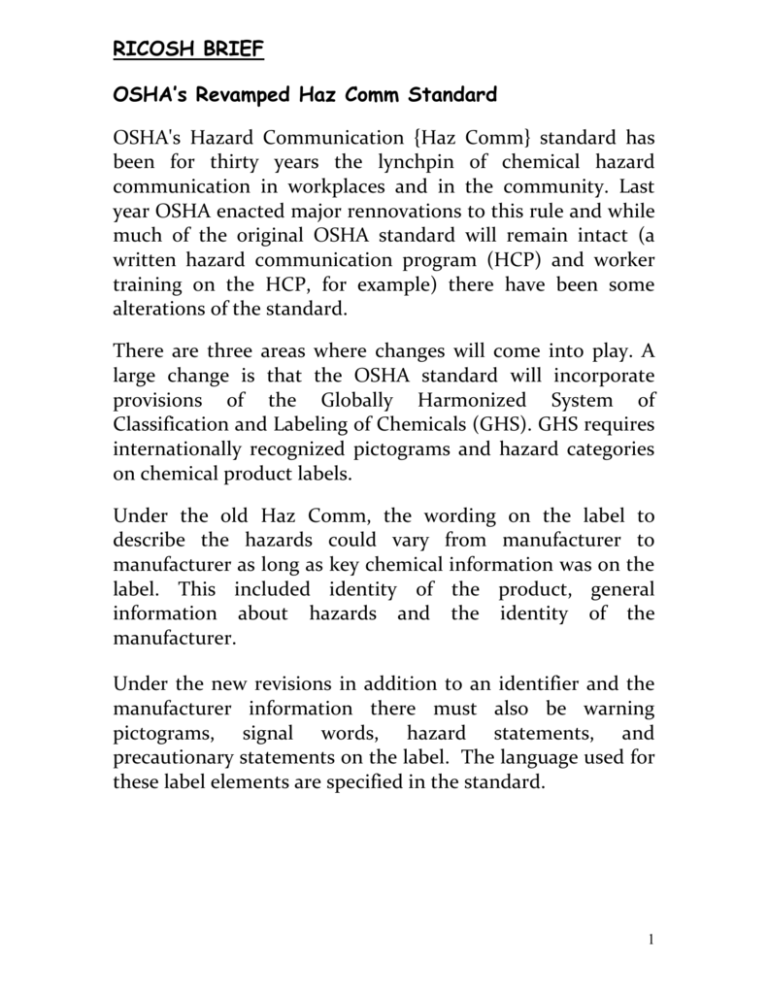
RICOSH BRIEF
OSHA’s Revamped Haz Comm Standard
OSHA's Hazard Communication {Haz Comm} standard has
been for thirty years the lynchpin of chemical hazard
communication in workplaces and in the community. Last
year OSHA enacted major rennovations to this rule and while
much of the original OSHA standard will remain intact (a
written hazard communication program (HCP) and worker
training on the HCP, for example) there have been some
alterations of the standard.
There are three areas where changes will come into play. A
large change is that the OSHA standard will incorporate
provisions of the Globally Harmonized System of
Classification and Labeling of Chemicals (GHS). GHS requires
internationally recognized pictograms and hazard categories
on chemical product labels.
Under the old Haz Comm, the wording on the label to
describe the hazards could vary from manufacturer to
manufacturer as long as key chemical information was on the
label. This included identity of the product, general
information about hazards and the identity of the
manufacturer.
Under the new revisions in addition to an identifier and the
manufacturer information there must also be warning
pictograms, signal words, hazard statements, and
precautionary statements on the label. The language used for
these label elements are specified in the standard.
1
Pictograms adopted from the GHS system that must appear
on all labels, e.g.:
The requirement for Precautionary Statements on each label goes
well beyond earlier requirements. Precautionary Statements
recommend measures that should be taken to minimize or prevent
adverse effects resulting from exposure to the hazardous chemical or
improper storage or handling. Four types of precautionary statements
2
are mandated: prevention (to minimize exposure); response in case of
accidental spillage or injury; storage; and disposal.
The “New” SAFETY DATA SHEETS
Chemical hazards have long been reported via Materials Safety Data
Sheets (MSDSs) which thirty years of HAZ Comm and state and local
Right –to- Know rules have made familiar to many. While vital to the
communication of chemical hazards and safe handling, storage and
transporting and emergency control measures some MSDS were
misleading, confusing, inadequate, and incomprehensible, and could
and did come in various formats and sizes. Research consistently
reported missing information on many, and some MSDSs were of such
poor quality and consistency that researchers deemed them useless.
The revised Haz Comm standard will standardize the format for all
safety data sheets (SDSs)-the “M” having been dropped. Preparers of
SDSs will be now required to use a standard format with 16 mandatory
sections with consistent headings in a specific sequence. And safety data
sheets will now have to include additional information about any
"hazards not otherwise classified" by GHS. Included among the
substances are asphyxiants, pyrophoric gases [gases that ignite upon
contact with air] and combustible dust.
The new standard requires that safety data sheet (SDS) information
"accurately reflects the scientific evidence used in making the hazard
classification" and to add any significant new information within three
months of becoming aware of this information.
Training on the new SDS is a critical component under the new
revisions. For example, an employee should be instructed that with the
new format, Section 8 (Exposure Controls/Personal Protection) must
always contain information about exposure limits, engineering
controls and other methods of controlling the hazard. Also the
training should emphasize how the information on a chemical’s label is
related to the corresponding SDS.
{The third area where there are significant changes in the Haz Comm
are related to definitions (e.g. Flammable) and hazard classifications
and specific criteria for classification of health and physical hazards, as
well as classification of mixtures.}
3
Chemical manufacturers, importers, distributors, and employers shall
be in compliance with all modified provisions by June 1, 2015, and
cannot ship containers without the new labeling system after
December 1, 2015
All “downstream” employers must update workplace labeling, the
hazard communication program, and provide any additional employee
training for newly identified physical or health hazards no later than
June 1, 2016. It is noteworthy, though, that the training requirements
for employees on these Haz Comm revisions --the new labeling
requirements and the new SDS format- - must be completed by this
year, Dec 1, 2013. The transition period between when workers must be
trained on the revisions and when employers must comply with all the
provisions will doubtless lead to some confusion.
<><><><>
OSHA estimates that these revisions will prevent more than 500
worker illnesses and injuries annually and 43 fatalities a year. They are
also projected to save US business somewhere in the neighborhood of
$1 billion annually due to streamlined and simplified hazard
communication training and other safety and productivity
improvements resulting from GHS.
There are still some gaps in the way chemical hazard information is
processed under the new rule. There remains the vexing issue of trade
secret restrictions which can limit access to chemical information. And
the rule has no mandate for independent auditing of the information
found on the safety data sheets.
THE OSHA website (OSHA.GOV) has extensive information on the
changes and should be consulted.)
RI Committee on Occupational Safety & Health
741 Westminster St. Prov RI 02903
(401) 751-2015/ricosh@verizon.net [10/13]
4
